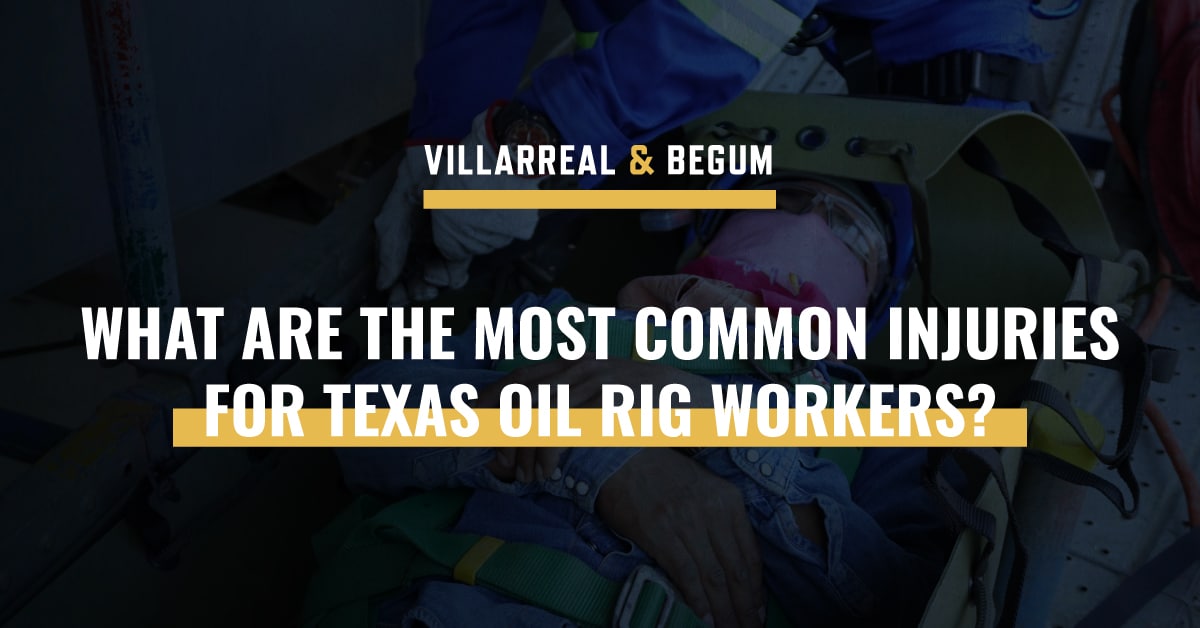
Working on an oil rig is no easy task. The demanding nature of the job, combined with the inherent risks present in the oil industry, can, unfortunately, lead to injuries, many of which can be catastrophic and even fatal. According to the United States Bureau of Labor Statistics, mining, quarrying, and oil and gas extraction account for an average of 107 worker deaths every year.
If you’re a Texas oil rig worker, these injuries can have a significant impact on your life and well-being. In this blog, the experienced team at Texas Law Guns, Injury & Accident Lawyers, will explore these injuries, shed light on your rights as an injured worker, and explain how a San Antonio oil drilling accident lawyer can help.
Common Injuries on Texas Oil Rigs
From falls and crush injuries to burns and respiratory issues, the physical toll on oil rig workers can be significant. Below is an overview of the most common injuries faced by these workers, along with their life-changing impacts.
Slips and Fall Injuries
Oil rig platforms are exposed to a range of substances such as oil, water, drilling fluids, or mud. These substances, when spilled or leaked, can create slippery surfaces, increasing the risk of slips and falls. Additionally, inclement weather conditions like rain or high humidity can contribute to slippery surfaces.
Other causes of slip and fall oil field injuries include:
- Uneven or Obstructed Surfaces: Oil rig platforms may have uneven or irregular surfaces due to the nature of the equipment and operations. Uneven flooring, loose grating, or debris can pose tripping hazards and lead to falls. Equipment and tools left in walkways or improperly stored can also create obstacles and increase the likelihood of accidents.
- Working at Height: Oil rig workers often need to perform tasks at elevated heights, such as working on scaffolding, walkways, or equipment platforms. Without proper safety measures in place, including guardrails, safety harnesses, and anti-slip surfaces, falls from heights can occur.
- Fatigue and Human Error: Fatigue, distraction, or rushing to meet deadlines can affect worker alertness and increase the likelihood of slips and falls. Inattentiveness, improper positioning, or misjudgment of surface conditions can all play a role in these incidents.
When a worker slips or loses their footing, the impact and subsequent fall can result in fractures, sprains, strains, and dislocations. In some cases, head injuries, including concussions or traumatic brain injuries, may occur if the individual’s head strikes a hard surface during the fall. Additionally, back and spinal injuries, such as herniated discs or spinal cord damage, can result from the impact of the fall. Other common injuries include cuts, bruises, and soft tissue damage.
Crush Injuries and Amputations
Crush injuries and amputations can occur on oil rigs due to the presence of heavy machinery and equipment. Malfunctions or failures of machinery like cranes, winches, or drilling equipment, can lead to crush injuries if they unexpectedly move, collapse, or exert excessive force on a worker.
Other causes include:
- Caught-between Hazards: Workers can get caught or trapped between heavy objects or equipment due to improper use, lack of proper safety protocols, or negligence. This can happen during equipment maintenance, repairs, or while moving heavy loads.
- Falling Objects: Oil rig operations involve the use of numerous tools, equipment, and materials that can fall from heights, potentially causing severe injuries. Falling objects can crush limbs, leading to injuries or amputations.
- Pinching or Squeezing: Oil rig workers may be at risk of getting body parts caught or squeezed between moving parts of machinery or equipment. This can happen during the operation of rotating equipment, such as gears, pulleys, or chains.
Burns
The presence of flammable materials, such as oil, gas, or chemicals, increases the risk of fires and explosions on oil rigs. Ignition sources, such as sparks, hot surfaces, or electrical malfunctions, can trigger these incidents, leading to severe burn injuries.
Other causes of burn-related oil field injuries include:
- Contact with Hot Surfaces or Steam: Workers may come into contact with hot surfaces, such as pipes, valves, or engines, causing burns. Steam leaks or releases can also lead to scalding injuries.
- Chemical Exposure: Oil rig workers may handle or work in close proximity to hazardous chemicals. Chemical spills or leaks can result in contact burns if these substances come into contact with the skin.
- Electrical Hazards: Faulty electrical equipment, improper wiring, or unsafe electrical practices can lead to electrical burns. Workers may suffer burns from electrical shocks or arc flashes, which can cause severe injuries.
- Welding and Cutting Operations: Welding and cutting activities on oil rigs involve the use of intense heat and open flames. Without proper safety measures, such as flame-resistant clothing, protective barriers, or proper ventilation, workers can sustain burns from direct exposure to these processes.
Musculoskeletal Injuries
Oil rig workers often engage in manual lifting and handling of heavy equipment, tools, or materials. Improper lifting techniques, overexertion, or inadequate training can lead to strains, sprains, and muscle injuries, particularly in the back, shoulders, and arms.
Other actions that lead to musculoskeletal oil field injuries include:
- Repetitive Motions and Vibrations: Performing repetitive tasks, such as operating machinery or using hand tools, can contribute to musculoskeletal injuries. Continuous, repetitive motions can cause strain, inflammation, and discomfort in muscles, tendons, and joints. Additionally, exposure to vibrations from machinery or equipment can lead to conditions like hand-arm vibration syndrome (HAVS).
- Fatigue and Long Work Hours: Prolonged work shifts and fatigue can impact workers’ physical performance, coordination, and judgment. Fatigue-related errors or loss of focus can lead to accidents and subsequent musculoskeletal injuries.
Head Injuries
Oil rig operations involve the use of heavy equipment, tools, and materials that may be positioned at heights. If these objects are not properly secured or safety protocols are not followed, they can fall and strike workers’ heads, leading to head injuries.
Other causes include:
- Slips, Trips, and Falls: Oil rig platforms may have slippery surfaces, uneven walkways, or obstacles that can cause workers to slip, trip, or fall. In such incidents, workers may hit their heads against hard surfaces or structures, resulting in head injuries.
- Struck-by Accidents: On oil rigs, there is a risk of being struck by moving equipment, machinery, or other objects. If a worker’s head comes into contact with a moving part or swinging object or collides with a solid structure, it can lead to head injuries.
- Falls from Heights: Oil rig workers often perform tasks at elevated heights, such as working on scaffolding, walkways, or rigging structures. Without proper fall protection measures or guardrails, falls from heights can occur, potentially resulting in severe head injuries.
What Should You Do if You’ve Been Injured on a Texas Oil Rig?
If you are injured on a Texas oil rig, it’s important to take the following steps:
- Seek Medical Attention: Seek immediate medical attention for your injuries. Report all symptoms and details to the medical professionals, as this documentation will be important for your claim or legal case.
- Report the Incident: Let your supervisor or employer know about the accident and your injuries as soon as possible. Follow the proper reporting procedures outlined by your company. Reporting the incident promptly ensures that there is a record of the incident and helps establish the timeline of events.
- Document the Scene: If possible, document the scene of the accident. Take photos or videos of any hazards, equipment involved, or conditions that contributed to the incident. This evidence can be valuable in supporting your claim or legal case.
- Gather Information: Collect the names and contact information of any witnesses who saw the accident or can provide information about the conditions leading up to it. Their testimonies may be crucial in establishing liability.
- Consult an Attorney: Seek legal representation from an experienced oil rig accident attorney. They will guide you through the process, protect your rights, and help you navigate the complex legal aspects of your case. An attorney will assess the circumstances, gather evidence, and advise you on the best course of action.
Remember, every case is unique, so it’s crucial to consult with an attorney who specializes in oil rig accidents to ensure your rights are protected and you receive the compensation you deserve for your injuries and losses.
Injured? Talk to an Oil Rig Accident Lawyer Today
Working on an oil rig can be physically demanding and potentially hazardous, but that doesn’t absolve employers, manufacturers, contractors, and other parties of liability when an accident occurs. If you’ve been injured, don’t hesitate to reach out to the skilled team at the Texas Law Guns, Injury & Accident Lawyers, for the support and expertise needed to navigate this challenging situation. We will protect your rights, assess your case, and help you seek the compensation you deserve.
See also:
WHO IS LIABLE IN AN OIL RIG EXPLOSION OR FIRE IN TEXAS?
San Antonio Plant and Refinery Explosion Lawyers
San Antonio Plant and Refinery Accident Lawyers
Filing a Lawsuit After an Oil Field or Offshore Accident
Longshore Workers Injury Lawyers

Alexander Begum has tried over 50 trials to verdict and tried or settled over $500 million in cases. Alex is a founding shareholder of the Texas Law Gun, Injury and Accident Lawyers.



